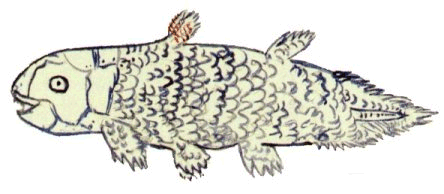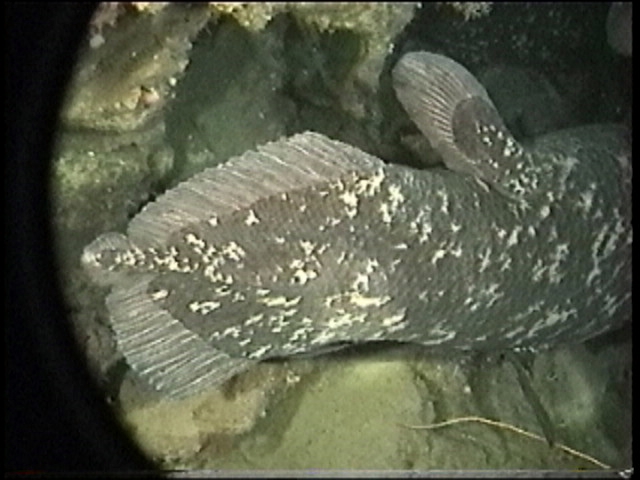
The sketch of the coelacanth sent to JLB Smith upon the discovery
of the original specimen of Latimeria chalumnae.
You have probably seen the news reports concerning the discovery of a population of coelacanths (Latimeria chalumnae) in deep water at Sodwana Bay. The coelacanth was originally discovered in South Africa (a lone wandering specimen!), and the only known populations of the fish were in the Comoros Islands for nearly 60 years. More recently, they have been found over a much wider area, including Moçambique, Madagascar and even Indonesia. On the 28th of October, several divers saw one on a deep dive in Sodwana, and during a subsequent series of dives in late November have discovered a population alive and well off our coast.
The first living coelacanth known to science was found on December 22nd, 1938 near East London. Previously thought to have been extinct for millions of years, a single fish was caught by the trawler Nerine near the Chalumna River. The captain of the vessel alerted the curator of the East London Museum, Marjorie Courtenay-Latimer, who found the unusual fish among the rest of the catch and recognised it as something special. Unable to identify the fish, she tried to contact JLB Smith at Rhodes University in Grahamstown, however, he was at that time holidaying in Knysna. JLB Smith eventually received a letter which included a sketch of the fish on the 3rd of January, and made the connection between the sketch and a 200 million year old fossil. He was only able to get to East London on the 16th of February and finally see the fish, by which time the internal organs had been discarded and the fish dry mounted. A 14 year search then ensued for another fish, including the distribution of thousands of leaflets up the coast of East Africa offering a reward of £100, a large sum of money in those days. Finally, in 1952, another specimen was found in the Comoros. A Dakota airplane was borrowed from the South African airforce to fetch the fish from the Comoros with the assistance of D.F. Malan, as time was running out for the specimen; the tropical heat and lack of refrigeration threatened to destroy it. The sensational story of the rediscovery of this living fossil caused a stir around the world, making front page news as far away as New York.

On the 28th of October, three divers, Pieter Venter, Peter Timm and Etienne le Roux went on a dive to 104m in Sodwana Bay. Near the end of the dive, Pieter Venter saw a eye peeking out at him and saw a completely unexpected sight - a coelacanth peering out at him from the cave. He called over Peter Timm and they saw two more coelacanths before the end of the dive. They did not report their sighting, but instead organised an expedition, dubbed the "SA Coelacanth Expedition 2000" to locate, film and identify the elusive fish. Their first dive on the 26th of November did not yield any coelacanths, however, 12 minutes into their second dive on Monday, the 27th of November they found 3 coelacanths in a cave at about 115m, which they took video and still images of. The expedition came to a tragic end with the death of one of the expedition's cameraman, Dennis Harding from a cerebral embolism, a result of an uncontrolled ascent. The news first appeared in the press on the 30th of November. Since then, Phil Heemstra, the project leader of the East Coast Fish-Watch project, and of course members of the coelacanth expedition have be besieged by calls from journalists from around the world and Phil has been extremely busy writing articles and trying to organise an expedition to study them using ROV's (remotely operated vehicles- small unmanned submersibles equipped with lights and cameras connected by a cable and controlled by a ship on the surface) and manned submersibles.

Two pictures of a coelacanth at 108m taken from a video tape filmed
during a
dive by the expedition that discovered the population in Sodwana
Bay.
Expeditions are being planned to study our population of the coelacanth. Phil Heemstra is trying to organise for the submersible Jago and Hans Fricke, famous for taking the first photographs of the coelacanth living in its natural habitat in the Comoros, to visit South Africa as soon as possible. Fortunately, the population lives within a protected area, and with the announcement of the discovery, the government promised to enact legislation to protect these special fish from disturbance. This legislation has now been enacted and it is now illegal to disturb, attempt to catch, locate or film the fish without a permit issued for that specific purpose. In an interesting development, Africam who brought us Shark Cam, Wreck Cam and Whale Cam to the Internet are thinking hard about the engineering challenges and possible benefits to science and the general public and the possible negative impacts on the coelacanths of installing an underwater "Coelacanth Cam" to film them and send this imagery to the Internet for the world to view.

Their habitat is - perhaps fortunately - far too deep for regular SCUBA diving, as at those depths, the oxygen in the air becomes deadly. To see such a renowned fish is a great temptation to all, but if scores of divers attempt to see this remarkable species, we don't know what effect it will have on them. Another consideration is the health of the people trying to see them - already, there has been the tragic loss of a life, and if other dives are conducted, more deaths may result, particularly if done by inexperienced divers. Diving to these depths cannot be taken lightly; it takes a lot of training, special gas mixtures and a lot of equipment and surface backup to safely undertake. The nearest recompression chamber is in Richard's Bay; the deeper the dive the greater the risk of decompression related problems, which can result in death or permanent disability. The great temptation to go and see these fish must be resisted as far as possible.
As more information on our population becomes available, we will bring it to you here!
The question in my mind at least is how far south do they extend? Perhaps others are lurking in deep water further south along our coastline.
This is perhaps the most exciting range extension we could possibly report!
The members of the "Coelacanth Expedition 2000" and Dr. Phil Heemstra have written an article for the South African Journal of Science which is due to be published in the next issue. You can find it here.
For some other details, you may be interested in reading some more stories on this subject on the IOL website: